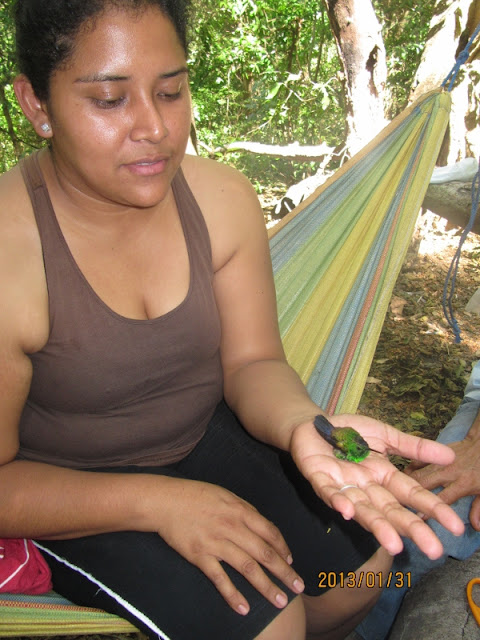in Nicaragua knows there are some great birds in this country. Observing birds by binoculars, however, still leaves many details unseen, as the photos below can demonstrate. We get a special opportunity to observe birds up close when
. There are few tasks as gratifying as one involving the observation of a living, wild bird up close, especially our birds here.
 |
| Leslie patiently waits for this Blue-tailed Hummingbird (Amazilia cyanura) to fly away. Photo by Emily Williams. |
By studying the birds in
Laguna de Apoyo Nature Reserve, we are learning about bird communities in the Nicaraguan tropical dry forest habitat that dominates the terrestrial areas in this protected area. We are also learning, however, about land use, by determining which birds are found in different areas according to the human activities in each. Some birds can use only good forest habitats, and they may be getting forced out by forest degradation. We are hoping to demonstrate consistent patterns in bird populations according to land use and to the changing forest structure as a reforested area grows back into a relatively mature, natural forest.
 |
| A Yellow-throated Vireo (Vireo flavifrons) wants to make his disagreement known. Photo by Emily Williams. |
At least 225 bird species have been documented in Laguna de Apoyo Nature Reserve, to date. Mist netting has helped us confirm several species which had been poorly documented by sightings. Many of the birds captured during mist netting, in appropriate season, are migratory birds, such as the Yellow-throated Vireo (
Vireo flavifrons) and the Painted Bunting (
Passerina ciris). Perhaps a quarter of the species found in Laguna de Apoyo Nature Reserve are migratory. Almost all migratory birds here nest further north and spend the non-breeding season here.
 |
| The male Painted Bunting (Passerina ciris) has dramatic coloration. Photo by Emily Williams. |
Some migratory birds winter in mixed-sex flocks, and others segregate by sex and/or age in their southern, nonbreeding range. By counting the birds by sex and age in Laguna de Apoyo, we can help to determine migration patterns for these birds. Appropriate habitat is required for all migratory birds, especially the Red-Listed species such as the
Painted Bunting (Near Threatened), and for all sexes and age classes.
 |
| Painted Bunting males are bright, whereas the females are drab. Photo by Emily Williams. |
Even when the migratory birds have returned to their nesting ranges, the forests and shoreline of Laguna de Apoyo Nature Reserve continue to be conspicuously occupied with birds. The year-round resident birds, which will have become even more evident when the migratory birds have gone, may even reproduce during the stay of most migratory birds, during winter in the northern hemisphere.
 |
| The White-tipped Dove (Leptotila verreauxi) is among the larger species we catch commonly in mist netting activities in Laguna de Apoyo Nature Reserve. Photo by Emily Williams. |
Not all birds use the same resources, of course. Many resident birds avoid areas with certain kinds of human impacts, such as the elimination of large, old trees, or the clearing of ground cover. The White-tipped Dove (
Leptotila verreauxi) is an example. It is common in forest, but quite uncommon in yards, even where the yards have large, old trees. Another resident bird which is affected by human activity is the Northern Barred Woodcreeper (
Lepidocolaptes sanctithomae). This species is common on the south side of Lake Apoyo, but absent from the north side, where greater human impacts are found on the vegetation structure.
 |
| The Northern Barred Woodcreeper (Dendrocolaptes sanctithomae) is not well-documented west of Lake Nicaragua. Photo by Emily Williams. |
Some of the local people brand us as tree-huggers, which is fine by us. We seem to get in the way of some people who have big plans for building inside the Laguna de Apoyo Nature Reserve, and they would rather that we go away. That gives us even more motivation to continue to work to save the forest and lake of this reserve. The greatest aspect of our bird studies is that of the people-those who are dedicated and even thrilled by the birds, and learn along the way. Our
conservation science interns and volunteers bring life to our projects.
 |
| Work as a volunteer in wildlife monitoring is exhausting but worthwhile. Photo by Emily Williams. |
The most thrilling of the birds we catch with mist nets must be the most demanding for our technicians, the
hummingbirds. They are the smallest and, by far, the most delicate of the birds we catch. Hummingbirds keep very little "reserve" to fuel their activities, requiring that they feed and drink often. We give the hummingbirds water when they are captured, and we process them as quickly as possible to allow them to resume their activities with little interruption. Hummingbirds are usually docile in the hand, and sometimes won't fly away immediately when released.
Hummingbirds are not easy to see well when on the wing, so having one in the hand is particularly special. One can appreciate so many particular features of these birds when they are still and close.
With all the information we gather, we are trying to find which birds are segregated by land use and what can be done about it. We are looking for clear recommendations to promote the entire reserve as good forest and lakeshore for the birds.
 |
| Click on the "escudo" to contact us. |








No comments:
Post a Comment